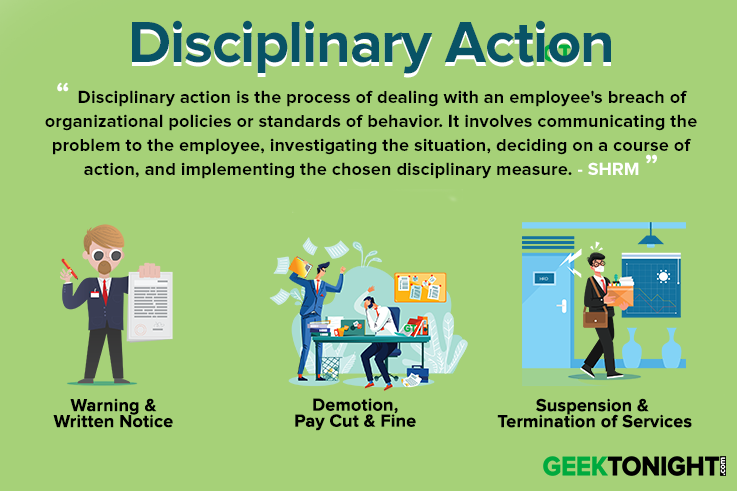What is Disciplinary Action?
Disciplinary action refers to the steps an employer takes to address and correct employee misconduct or performance problems. These steps may include verbal or written warnings, performance improvement plans, suspension, demotion, or termination of employment.

Table of Content
Disciplinary Action Definition
Disciplinary action is a management tool used to ensure compliance with company policies and procedures. It is the process of enforcing the rules and standards of behavior expected of employees and dealing with the consequences of non-compliance. – Society for Human Resource Management (SHRM)
Disciplinary action refers to the process of correcting or enforcing certain behavior or actions by employees that are deemed inappropriate or harmful to others in the workplace. It involves a range of corrective measures, including verbal and written warnings, suspension, demotion, or termination of employment. – Gary Dessler, author of “Human Resource Management”
Disciplinary action is the process of dealing with an employee’s breach of organizational policies or standards of behavior. It involves communicating the problem to the employee, investigating the situation, deciding on a course of action, and implementing the chosen disciplinary measure. – The International Labour Organization (ILO)
Types of Disciplinary Action
The disciplinary actions taken should be seen primarily as a corrective measure, aimed at preventing further misconduct or poor performance.
- Warning: This is the mildest form of disciplinary action and is usually applied at a minor offence. These are given orally and very leniently. Warnings can be given verbally or in written form.
Verbal warnings are usually given when there is a minor offence of misconduct; in case verbal warning fails to produce the desired result the organization resorts to a warning in written form for stricter action. These warnings do not produce any effect on the employee’s status or wages in the organization. - Written Notice: When warning does not work and the employees continue with the same misconduct, it becomes necessary to issue a written notice implying certain punishment.
- Suspension: This disciplinary action is temporary in nature. In this an employee is prohibited from performing the duties assigned to him for a certain period of time.
Under this employee is refused to perform his task for few days or months depending on the nature of misconduct. Later on, after the completion of his punishment period employee can rejoin his job. - Demotion: It is only used in a case when an employee does not meet his present job requirements or standards. When he is not able to give good performance on his job he is posted one rank below his present rank in the organization.
- Fines : It is the kind of punishment where the amount of fine is deducted from the remuneration of employee for his misconduct. A penalty is charged from the employee if he is breaking any rule repeatedly.
- Pay Cuts: When an employee provides any loss or harm to the property of the organization or take leave without permission etc he is not paid with his full remuneration and the amount of loss or damage is deducted from his pay.
- Holding increments: It comes under major punishment. When an employee is about to receive his increment but due to the disciplinary action taken against him, his annual increment is put on a hold for some time.
- Termination of services: It is the severe punishment which makes an employee disqualified from his employment. This is the last stage of any disciplinary action when there is no other choice left for the employer to punish the employee.
Steps in Disciplinary Actions
- Preliminary Investigation
- Issue of Charge Sheet
- Meeting with the accused
- Notice of Enquiry
- Holding a full-fledged enquiry
- Findings by the enquiry officer
- Making final decision of punishment
Preliminary Investigation
The first step is to hold preliminary investigation into any allegation of misconduct. Information is gathered from various sources like witnesses to alleged incidents etc and an investigation report is prepared.
Issue of Charge Sheet
If misconduct exists, the management should proceed to issue a charge sheet in writing to the employee. A charge sheet is a formal document of accusation and legally abiding on the accused.
Meeting with the accused
After issuing the charge sheet to the employee a meeting should be fixed with the accused employee. He should be given a chance to explain the reason behind the misconduct. There may be another side to the situation which is not being covered in the investigation from other sources.
Notice of Enquiry
After replying to the charge sheet, following two situations may arise:
- If the employee admits the charges on him, the employer will give him punishment at that time only without any further enquiry.
- If an employee denies the charge, the employer will hold a further enquiry.
Holding a full-fledged enquiry
When the employee denies the charges a fullfledged enquiry is conducted where all the details are studied by the enquiry officer. Various witnesses are questioned and the sequence of events are monitored.
Findings by the enquiry officer
The enquiry officer after proper investigations should decide whether the charges made upon the employee are valid or not.
Making final decision of punishment
If the enquiry officer proves charge upon the employee, the employer or the legal authority may award punishment to the employee. The punishment would depend on the gravity of the misconduct. It might be a temporary punishment like suspension, a monetary fine etc or if misconduct deserves a severe punishment the employee’s services may be terminated.
The punishment should be communicated to the employee in a written letter which should contains all details regarding the charge sheet, the enquiry, the findings of the enquiry, decisions taken, the date from which the punishment is to be effective. Still, if the employee feels that the enquiry conducted was not proper or the action taken is unjustified he might appeal for reconsideration of his case.
Features of an Effective Disciplinary Action
Corrective rather than punitive
The main objective of a disciplinary system should be to correct the behavior and maintain the performance of the employees rather than punishing them. He will feel more sense of belongingness towards the organization and they get motivated to follow the rules and regulations set by the organization.
Progressive disciplinary approach
Discipline system should be progressive in nature. A progressive disciplinary approach starts with a mild corrective action taken initially which progresses in severity if the employee continues to show improper behavior.
Under this approach the employees get enough time to correct their actions and they do not take it for granted.
Should follow “The Red hot Stove Rule”
According to the hot stove rule it is believed that any delay in conducting a disciplinary action defeats the entire purpose behind it. A disciplinary action should have the same features and effects that are attained by touching a hot stove.
The “red hot stove” rule draws a parallel between touching a red hot stove and violating rules of discipline. When a person touches a hot stove below are the consequences which can be related to a disciplinary action as well
- Burns immediately: Any delay in the disciplinary action spoils the entire purpose of taking it, delayed disciplinary action leaves the accused wondering about the reason behind it. If disciplinary action is to be taken, it should be taken immediately so that the person will understand the reason for it.
Delayed disciplinary action also brings down the morale of the other employees who are constantly abiding by the rules and regulations of the organization. - Provides warning: Since the person feels the heat if he goes near the hot stove it acts as a warning that if he moves further closer and touches the hot stove he might burn himself.
- Gives consistent punishment: It burns everyone who touches it, hence shows consistent results every time without any exception.
- Burns impersonally: Disciplinary action is impersonal as there is no bias involved similar to a hot stove that burns anybody who touches it without showing any favoritism.
Training of supervisors
Supervisors and managers need to be trained on when and how the disciplinary action should be used. There is a certain amount of judgment and communication skills that are required while dealing with the employees creating a disturbance in the organization.
Moreover, discipline decisions taken by trained supervisors are considered fair by both employees and managers as they would follow fair and informed practices while conducting any disciplinary action.
Discipline should be fair
Every employee should receive the same punishment for the same offence. There should be absence of bias and no favoritism while deciding upon a disciplinary action against someone who has committed an offence. If different punishments exist for the same offence, it would lead to partiality.
Disciplinary action should be prompt
Effective discipline should be immediate. The longer time lag between the misconduct offense and the disciplinary action defeats the entire purpose of it. An employee will take it very leniently and forget it very soon.
Follow-up
The employees must be informed clearly about what constitutes good behavior and the punishments for their misconduct they may get. Once the disciplinary action is taken a proper follow-up needs to be conducted where the change in the behavior of the employee who has been punished should be observed and it should be made sure that there is an improvement in his behaviour
Human Resources Tutorial
(Click on Topic to Read)





